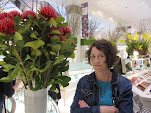



The continuing day of adventure in an English castle that led to a textile discovery...
Even though we were anxious to tour around the grounds, we were hungry and wanted to get warmed and revitalized. The woman who gave us our tickets pointed the way to a garden café. Walking through the dripping shrubs and trees, on our way to the tearoom, we saw a large group of completely soaked teen-agers rushing in the opposite direction. They were French students escaping back into their bus. Hopefully, they were able to glean some enrichment from their field trip.
The café was warm and cozy with lovely soups, tea, breads and other perfect lunch items. The walls were full of windows that gave a nice view of the surrounding gardens. We could hear the wind squeaking through the cracks and see it whipping the branches back and forth. After soup, sandwich and some yogurt, I indulged my daughter with hot chocolate and a donut and I sipped hot milky tea. Mira kept smiling at me and telling me that I was the best mommy in the world. At that moment, I felt like I was definitely a contender. Sometimes it’s easy to be a good mother. I wanted to hold that moment and never let it end. Part of me said it was time to move on so we could see what there was to see.
Inside we went to the information center first to get some activity materials that they have especially for children. Out of three or four different activities, Mira chose one that involved exploring possible ghost sightings. We had a great time investigating the various locations where people had reported stories of ghosts over the years. This got us moving around the castle and gave us some background on various historic people and incidents. Since the storm was blowing the windows and things seemed dark and empty, it was not hard to imagine that there might be some truth to the stories. At one point we heard a loud high voice rising up through the halls. Everyone, including the guards, stopped and stared, then another guard walked by and said that the soprano from the opera was going to be performing at a special dinner there and she was practicing.
Wandering around, I kept my eyes open for textile sightings as well. In several of the rooms, there were 15th century Belgian tapestries that hung from the ceiling to the floor, just where they have been hanging for about the past four hundred years. They were originally hung as decoration but also to keep the rooms warmer and sometimes to conceal secret doorways. It is unbelievable that they are still in such good condition.
Other textiles that I noticed were the beddings. Silk covered the quilts, pillows and canopies as well as the actual posts and bed frames. These, I found out, had not survived in their original condition, but were restored. In one room, the entire bed was covered in burgundy silk brocade and in another room it was gold. The whole effect was very rich but plain which was typical of much of the English style at that time.
In the chapel, there were kneelers that had been needlepoint stitched with various royal insignia or images of Hampton Court Palace. There was a thistle, which stands for the Stuart family and the Tudor rose. There was also the image of four pillars, each with a different pattern on it. I had seen this image and actual pillars like it around London but I did not know what it represented. It is common to see stitched kneeling pillows in chapels and churches around England. These are done by the local churchwomen and donated to the church. This ancient tradition carried over to modern life, is just another example of the status and prominence of needlework in English society.
(The final part next tuesday..)
(I can't believe that after searching through hundreds of images on the web, I can't find any of the needlepoint kneelers at Hampton Court. I have seen such a variety of needlepoint images -good and bad - that I am going to have to do another post just on that. Unfortunately, when I was there, it was before digital cameras and my photos are packed away. I will try to dig them out! so the photos at the top are the closest I could get.)
1. An embroidery done by Mary Queen of Scots
2. An authentic reproduction of a Tudor bed with embroidered fabric made by Stuart Interiors.
3. A screen embroidered by Anne Boleyn
4. Needlepoint Kneelers from a different church in England (sorry I don't know which)





No comments:
Post a Comment